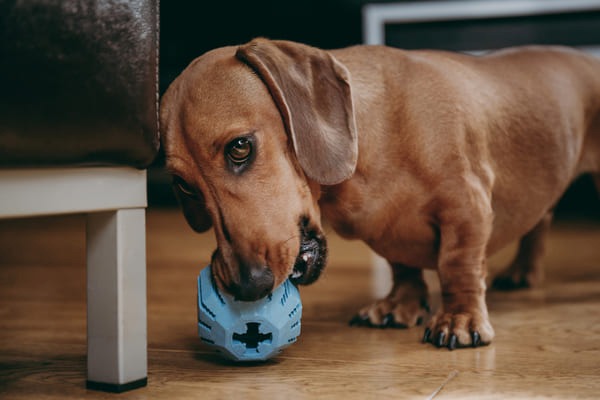

Is My Dog Mad at Me?
Has your best friend’s behavior taken a turn for the unfriendly? Animalia takes a look at canine emotions to help owners smooth over their relationships with their pets and build a stronger bond.

Writer Animalia Team
6 min read

It’s no fun to feud with human friends and members of the family. It’s worse, however, to feel like our dogs (our proverbial ‘best friends’) have put us in the doghouse. A change in your dog’s behavior can be worrying, especially if they’re going out of their way to avoid you, are kicking up a fuss, or seem eager for a conflict. At the same time, it’s important not to anthropomorphize our pets and attach human emotions to their behavior. There might be something causing a change in their mood, but this doesn’t mean they’re angry with you.
Can dogs feel emotions?
Researchers have now come to believe that the mind of a dog is roughly equivalent to that of a two years old toddler. This conclusion holds for most mental abilities as well as emotions.
At birth, a human infant only has an emotion that we might call excitement. This indicates how excited he is, ranging from very calm up to a state of frenzy. Within the first weeks of life the excitement state comes to take on a varying positive or a negative flavor, so we can now detect the general emotions of contentment and distress. In the next couple of months, disgust, fear, and anger become detectable in the infant. Joy often does not appear until the infant is nearly six months of age and it is followed by the emergence of shyness or suspicion. True affection, the sort that it makes sense to use the label “love” for, does not fully emerge until nine or ten months of age.
The complex social emotions—those which have elements that must be learned—don’t appear until much later. Shame and pride take nearly three years to appear, while guilt appears around six months after that. A child is nearly four years of age before she feels contempt. This developmental sequence is the golden key to understanding the emotions of dogs. This means that a dog will have all of the basic emotions: joy, fear, anger, disgust, and love, but will not experience the more complex emotions like guilt, pride, and shame.
Signs your dog might be annoyed with you
Dogs are complex creatures. Although they can’t communicate their feelings with words, there are plenty of methods they use for letting their owners know they’re feeling unhappy about something.
Your dog is ignoring you
Is your dog keeping more of a distance between the two of you than usual? If your favorite pooch is usually a sucker for hugs and snuggles, avoidant behavior can be hard to stomach. Just because they’re giving you a wide berth doesn’t mean your dog has taken issue with you. Instead, an underlying health issue could be to blame.
Unlike humans, dogs can’t describe their symptoms when they’re feeling unwell. If they’re going out of their way to avoid contact with you, they may just be feeling a bit under the weather. For peace of mind, it’s best to get in for a closer look. If you suspect something is wrong, it’s time to schedule a trip to the vet. Antisocial and avoidant behavior can also be a sign of depression. Have there been any major changes in your household recently? Has a grown child left the nest? Has a new baby joined the family and started stealing attention? Any of these changes can disturb the status quo, leading to changes in your dog’s mood.
Your dog is not as affectionate as they usually are
Are you noticing a sudden change in your dog’s behavior? If you’re not getting the usual attention from your four-legged companion, don’t jump to conclusions. They’re not trying to tell you they don’t want to be pals anymore. When dogs keep their distance, they’re usually keeping something to themselves. An active and affectionate dog who suddenly steers clear of you may have recently suffered an injury. If you suspect something is up, get in touch with your vet ASAP.
Hide-and-seek is their new favorite pastime
It’s not uncommon for dogs to seek out hiding spaces in the home, but the behavior is usually tied to anxiety. Ever noticed how your dog sulks off during bad weather? Perhaps your pooch runs for cover when the vacuum cleaner comes out. There are plenty of things that trigger an avoidance response in your dog. Consider the obvious causes before starting to worry.

Your dog is peeing everywhere
If an older dog is suddenly peeing everywhere, it’s easy to assume that they’re acting up. However, these messy protests aren’t typically a sign of bad behavior or ill will. If your dog hasn’t been neutered, you may be dealing with scent-marking behavior. It can also be a stress reaction. What changes have happened in the household? Have new people been thrown into the mix? Sometimes, excessive peeing can be a sign of an underlying health condition. Talk to your vet sooner rather than later if you notice additional signs of trouble.
Your dog is chewing everything in sight
Have you arrived home to find your furniture or favorite footwear in pieces? Your dog probably hasn’t done this to annoy you. Instead, they’re likely just bored and looking to amuse themselves. Try providing your pooch with plenty of toys they can occupy themselves with. Consider spending a premium on treat dispensers and interactive toys that will keep them entertained for hours.

Your dog is displaying aggressive behavior
There’s nothing worse than being on the receiving end of a bark, growl, or snarl. Your dog isn’t angry at you, they’re letting you know that they’re not happy about something. Most of the time, you’re dealing with a resource-guarding response.

What can I do to stop my dog from being mad at me?
Is your dog exhibiting any of the signs outlined above? If gentle coaxing or a positive change in routine hasn’t remedied the problem, now is the time to seek a professional opinion. Sometimes, you may be dealing with a dog that needs some retraining. Other times, an avoidant pet may be hiding a health condition or injury that needs urgent attention. Whatever the case, undesirable behavior is never a sign that your dog is actually angry with you.
Whatever ups and downs your relationship with your dog brings, Animalia pet insurance is there to support you both. Even with free behavioral treatments by dog trainers or behaviorists. Get a quote today to learn more.





We offer the most
comprehensive coverage
out there
car with a spare tire for life’s bumps.
Having Animalia is like a pimped-out
Rolls Royce with a swimming pool
in the trunk.



Get your pet insurance quote
Pet type
- Dog
- Cat
What is your pet's name?
Zip code





